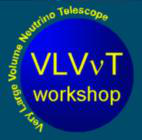Orateur
Mlle
Jessica Craig
(Oceanlab , University of Aberdeen)
Description
The density of bioluminescent organisms was measured in the eastern and western Mediterranean, from the subsurface layer to the seafloor; in the Ligurian, Tyrrhenian, Ionian, Adriatic Seas and the Straits of Sicily, including neutrino telescopes sites at ANTARES and NESTOR. Bioluminescence decreased with depth at different rates at the different sites. At depths 500-1500m, the Adriatic was found to have the highest mean density (2.5 m-3), and the eastern Ionian Sea (NESTOR) to have the lowest (0.3 m-3), while the Strait of Sicily, the Tyrrhenian, the western Ionian and the Ligurian (ANTARES) Seas showed very similar values of 1.38, 1.53,1.53 and 1.65 m-3 respectively. Deeper within the water column (1500-2500m), the strait of Sicily and the Ligurian Sea were found to have the highest densities (0.74 and 0.62 m-3), and the Ionian sites to have the lowest; 0.21 m-3 in the western and 0.06 in the eastern sectors. Modelling encounter of bioluminescent organisms carried in deep sea currents impinging on a telescope photodetector predicts bioluminescent flashes, 16.59 h-1 at ANTARES and at NESTOR 1.84 h-1 at 1500-2500m depth, 1.16 h-1 at 2500-3500m and 0.49 h-1 at >3500m.
Auteurs
Dr
Alain F Zuur
(Highland Statistics Ltd.)
Dr
Alan Jamieson
(Oceanlab , University of Aberdeen)
Dr
Amandine Heger
(Oceanlab , University of Aberdeen)
Prof.
I.G. Priede
(Oceanlab , University of Aberdeen)
Mlle
Jessica Craig
(Oceanlab , University of Aberdeen)

